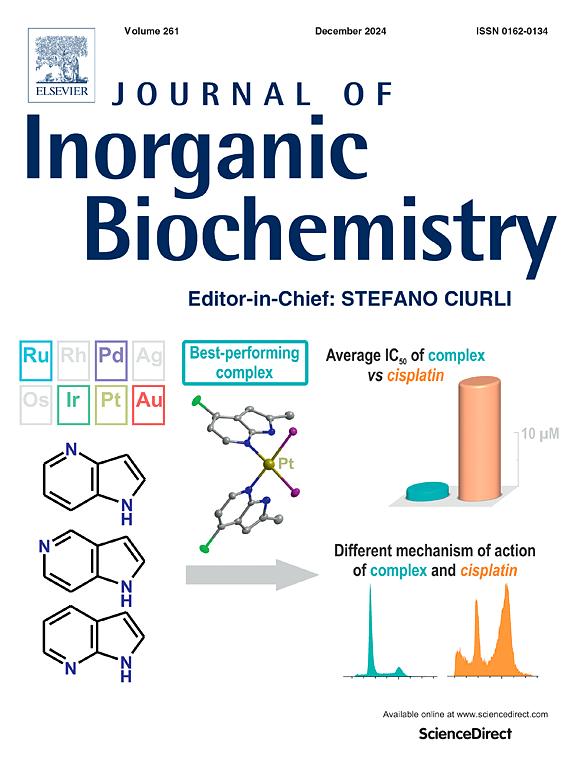Anticancer organometallic half-sandwich complexes of estrone-derived (N,N) donor ligands with enhanced aqueous solubility
IF 3.8
2区 化学
Q2 BIOCHEMISTRY & MOLECULAR BIOLOGY
引用次数: 0
Abstract
Four steroidal derivatives (L1-4) bearing an (N,N) metal-chelating subunit on the D-ring, in addition to the organometallic [M(arene)(N,N)Cl]Cl complexes of L1,2 were synthesized and characterized, in which M(arene) is Rh(III)(η5-C5Me5) or Ir(III)(η5-C5Me5) or Ru(II)(η6-p-cymene). The solution chemical properties of both the estrone-based ligands and selected complexes were investigated by spectroscopic methods. At pH = 7.4, the ligands are predominantly positively charged, moderately lipophilic (logD7.4 = +0.6 − +3.2), and exhibit low-to-medium micromolar solubility (S7.4 = 9–543 μM) and are more hydrophilic than estrone; however, complexation improved the aqueous solubility of the obtained organometallics. The Rh(η5-C5Me5) and Ru(η6-p-cymene) complexes of L1 demonstrated high stability in solution (<1 % bidentate ligand dissociation at pH 7.4 for 48 h), forming a higher fraction of mixed hydroxido species [M(arene)(N,N)(OH)]+ in the case of the Ru complexes. Both coordination and intermolecular interactions of the organometallic complexes with human serum albumin were observed. The ligands and their complexes were tested in human cancer cell lines to investigate their in vitro anticancer activity. Studies in Colo-205 and MCF-7 cells revealed the moderate-to-strong cytotoxicity of the ligands (IC50 = 5–50 μM) with limited selectivity toward cancer cells over the non-cancerous CCD-19Lu fibroblast cell line. Complexation increased the cytotoxicity, especially for Rh(III)(η5-C5Me5) and Ir(III)(η5-C5Me5) complexes in the MCF-7 cell line compared to the ligands.

具有增强水溶性的雌酮衍生(N,N)供体的抗癌有机金属半夹心配合物
合成了四种甾体衍生物(L1-4),在d环上有一个(N,N)金属螯合亚基,以及有机金属[M(芳烃)(N,N)Cl]Cl的L1,2配合物,其中M(芳烃)是Rh(III)(η5-C5Me5)或Ir(III)(η5-C5Me5)或Ru(II)(η6-对伞花烃)。用光谱学方法研究了雌酮基配体和所选配合物的溶液化学性质。在pH = 7.4时,配体主要带正电荷,具有中等亲脂性(logD7.4 = +0.6 ~ +3.2),具有中低微摩尔溶解度(S7.4 = 9 ~ 543 μM),亲水性优于雌酮;然而,络合提高了所得到的有机金属化合物的水溶性。L1的Rh(η - 5- c5me5)和Ru(η - 6-对花葶烃)配合物在溶液中表现出很高的稳定性(<; 1%双齿配体在pH 7.4下解离48 h), Ru配合物形成更高比例的混合羟基[M(芳烃)(N,N)(OH)]+。观察了金属有机配合物与人血清白蛋白的配位和分子间相互作用。在人肿瘤细胞系中检测了这些配体及其复合物的体外抗癌活性。在Colo-205和MCF-7细胞中的研究表明,该配体对癌细胞具有中等至强的细胞毒性(IC50 = 5-50 μM),与非癌性的CCD-19Lu成纤维细胞系相比,选择性有限。与配体相比,络合增加了MCF-7细胞系中Rh(III)(η - 5- c5me5)和Ir(III)(η - 5- c5me5)复合物的细胞毒性。
本文章由计算机程序翻译,如有差异,请以英文原文为准。
求助全文
约1分钟内获得全文
求助全文
来源期刊

Journal of Inorganic Biochemistry
生物-生化与分子生物学
CiteScore
7.00
自引率
10.30%
发文量
336
审稿时长
41 days
期刊介绍:
The Journal of Inorganic Biochemistry is an established international forum for research in all aspects of Biological Inorganic Chemistry. Original papers of a high scientific level are published in the form of Articles (full length papers), Short Communications, Focused Reviews and Bioinorganic Methods. Topics include: the chemistry, structure and function of metalloenzymes; the interaction of inorganic ions and molecules with proteins and nucleic acids; the synthesis and properties of coordination complexes of biological interest including both structural and functional model systems; the function of metal- containing systems in the regulation of gene expression; the role of metals in medicine; the application of spectroscopic methods to determine the structure of metallobiomolecules; the preparation and characterization of metal-based biomaterials; and related systems. The emphasis of the Journal is on the structure and mechanism of action of metallobiomolecules.
 求助内容:
求助内容: 应助结果提醒方式:
应助结果提醒方式:


